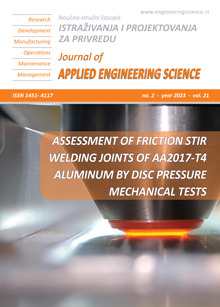INTERCEPTOR'S EFFECT ON TURNING MANEUVER PERFORMANCE WITH OPEN FREE RUNNING MODEL TEST METHOD
Abstract
It is necessary for the ship to have the capability of maneuvering when it is operating out at sea in order to protect the ship from the risk of colliding with other objects. To increase maneuverability, it is proposed to deploy interceptor devices on the two sides of the ship's stern, where the height of the interceptor blades can be adjusted. The working principle is to restrict the flow of fluid on one side at the stern in order to generate greater pressure than the other side, so that the fluid flowing towards the stern of the ship experiences a high-speed difference between one side and the other, resulting in an increase in side force. In this paper, the open free-running test method is used to test the interceptor's ability to turn on a model of a fast ship. The ship model is fitted with a GPS device, a control system, a motor, and a communication system. The case study of the interceptor mounted on two distinct sides at the ship's stern is conducted with various combinations of interceptor blade height (d) between the two sides, including 100% d, 50% d, and 0% d. The test findings consist of model trajectory, velocity, and an IMO standard maneuver. The combination of 100% d at portside, 0% d at starboard side, and the rudder pointing portside at 35 degrees angle resulted in the best tactical diameter, which is 21.49% smaller than without the interceptor.
References
Indonesian National Transportation Safety Committee (KNKT Indonesia). (2019). Harapan Baru Express VII collision in the Tanjung Urong River, Tana Tidung, North Kalimantan, Republic of Indonesia. KNKT report no. 18.05.14.03, Jakarta.
Lihua, L., Peng, Z., Songtao, Z., Jia, Y. (2019). Simulation analysis of fin stabilizers on turning circle control during ship turns. Ocean Engineering, vol. 173, 174–182.
Du, L., Banda, O.A.V., Huang, Y., Goerlandt, F., Kujala, P., Zhang, W. (2021). An empirical ship domain based on evasive maneuver and perceived collision risk. Reliability Engineering and System Safety, vol. 213, 107752.
Jacobi, G., Thill, C. H., van’t Veer, R., Huijsmans, R. H. M. (2019). Analysis of the influence of an interceptor on the transom flow of a fast ship by pressure reconstruction from stereoscopic scanning PIV. Ocean Engineering, vol. 181, 281–292.
Avci, A. G., Barlas, B. (2019). An experimental investigation of interceptors for a high-speed hull. International Journal of Naval Architecture and Ocean Engineering, vol. 11, no. 1, 256–273.
Mansoori, M., Fernandes, A. C., Ghassemi, H. (2017). Interceptor design for optimum trim control and minimum resistance of planing boats. Applied Ocean Research, vol. 69, 100–115.
Song, K.W., Guo, C., Li, P., Wang, L. (2018). Influence of interceptors, stern flaps, and their combinations on the hydrodynamic performance of a deep-vee ship. Ocean Engineering, vol. 170, 306–320.
Jangam, S. (2022). CFD based prediction on hydrodynamic effects of Interceptor and flap combination on planing hull. Ocean Engineering, vol. 264, 112523.
Seok, W., Park, S. Y., Rhee, S. H. (2020). An experimental study on the stern bottom pressure distribution of a high-speed planing vessel with and without interceptors. International Journal of Naval Architecture and Ocean Engineering, vol. 12, 691–698.
Sahin, O. S., Kahramanoglu, E., Cakici, F. (2022). Numerical evaluation on the effects of interceptor layout and blade heights for a prismatic planing hull. Applied Ocean Research, vol. 127, 103302.
Hafiz, M.A., Sulisetyono, A. (2020). Study of the interceptor’s effect on ship manoeuvrability using the open free running test method. Proceedings of 5th International Conference on Marine Technology (SENTA 2020), Surabaya, Indonesia.
Sulisetyono, A. (2018). The Simple Open Free Running Test for the Evaluation of Turning Ship Ability. Proceedings of 6th International Seminar on Ocean and Coastal Engineering, Environmental and Natural Disaster Management (ISOCEEN 2018), Surabaya, Indonesia.
Jin, H., Wu, H., Xu, Z., Huang, W., & Liu, C. (2022). Travel-mode classification based on GPS-trajectory data and geographic information using an XGBoost classifier. IOP Conference Series: Earth and Environmental Science, vol. 1004(1), 012012.
IMO. (2002). Standards for ship manoeuvrability. In Resolution MSC.137(76). International Maritime Organization.
Asfihani, T. et al. (2017). Estimation of the corvette SIGMA motion in missile firing mission. Proceedings of the 5th International Conference on Instrumentation, Control, and Automation (ICA), Yogyakarta, Indonesia, p. 203–207.
Sulisetyono, A., Putranto, T. (2017). Wave Load Analysis of the Corvette Ship in the Sea Water of Indonesia. Applied Mechanics and Materials, vol. 862, 291–295.
Putranto, T., Sulisetyono, A. (2015). Analisa Numerik Gerakan dan Kekuatan Kapal Akibat Beban Slamming Pada Kapal Perang Tipe Corvette (in Indonesian). Kapal, vol. 12, 158–164.
ITTC. (2008). Procedure Free Running Model Tests. In ITTC - Recommended Procedures and Guidelines. International Towing Tank Conference.
Schlichting, H. (1979). Boundary-layer theory (7th ed). McGraw-Hill, New York.
Maria, E., Budiman, E., Haviluddin, Taruk, M. (2020). Measure distance locating nearest public facilities using Haversine and Euclidean Methods. Journal of Physics: Conference Series, vol. 1450, 012080.

